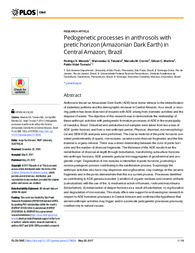Pedogenetic processes in anthrosols with pretic horizon (Amazonian Dark Earth) in Central Amazon, Brazil.
Pedogenetic processes in anthrosols with pretic horizon (Amazonian Dark Earth) in Central Amazon, Brazil.
Autoria: MACEDO, R. S.; TEIXEIRA, W. G.; CORRÊA, M. M.; MARTINS, G. C.; VIDAL-TORRADO, P.
Resumo: Anthrosols known as Amazonian Dark Earth (ADE) have borne witness to the intensification of sedentary patterns and the demographic increase in Central Amazon. As a result, a recurring pattern has been observed of mounds with ADE arising from domestic activities and the disposal of waste. The objective of this research was to demonstrate the relationship of these anthropic activities with pedogenetic formation processes of ADE in the municipality of Iranduba, Brazil. Disturbed and undisturbed soil samples were taken from two areas of ADE (pretic horizon) and from a non-anthropic pedon. Physical, chemical, micromorphological and SEM-EDS analyses were performed. The coarse material of the pretic horizons consisted predominantly of quartz, iron nodules, ceramics and charcoal fragments, and the fine material is organo-mineral. There was a direct relationship between the color of pretic horizons and the number of charcoal fragments. The thickness of the ADE results from the redistribution of charcoal at depth through bioturbation, transforming subsurface horizons into anthropic horizons. ADE presents granular micro aggregates of geochemical and zoogenetic origin. Degradation of iron nodules is intensified in pretic horizons, promoting a reverse pedogenic process contributing to the xanthization process. Surprisingly the anthropic activities also favor clay dispersion and argilluviation; clay coatings on the ceramic fragments and in the pores demonstrate that this is a current process. Processes identified as contributing to ADE genesis included: i) addition of organic residues and ceramic artifacts (cumulization) with the use of fire; ii) mechanical action of humans, roots and macrofauna (bioturbation); iii) melanization of deeper horizons as a result of bioturbation; iv) argilluviation and degradation of iron nodules. This study offers new support to archaeological research in respect to ADE formation processes in Central Amazon and confirmed the hypothesis that ancient anthropic activities may trigger and/or accelerate pedogenetic processes previously credited only to natural causes.
Ano de publicação: 2017
Tipo de publicação: Artigo de periódico
Unidade: Embrapa Solos
Palavras-chave: Antrossolo, Processo pedogenético, Terra preta de índio
Observações
1 - Por padrão são exibidas publicações dos últimos 20 anos. Para encontrar publicações mais antigas, configure o filtro ano de publicação, colocando o ano a partir do qual você deseja encontrar publicações. O filtro está na coluna da esquerda na busca acima.
2 - Para ler algumas publicações da Embrapa (apenas as que estão em formato ePub), é necessário ter, no celular ou computador, um desses softwares gratuitos. Sistemas Android: Google Play Livros; IOS: iBooks; Windows e Linux: software Calibre.
Acesse outras publicações
Acesse a Base de Dados da Pesquisa Agropecuária (BDPA) para consultar o acervo completo das bibliotecas da Embrapa.

